The Historic Pageant of Mount Grace Priory (1927)
*Guest post by Tosh Warwick, produced as part of the Heritage Lottery Fund supported Tees Transporter Bridge Visitor Experience Project*
Lady Bell’s Historic Pageant of Mount Grace Priory, which took place in 1927, brought thousands of spectators from across North Yorkshire, County Durham and further afield to the country estate of the Bell manufacturing dynasty. Participants and performers were united in celebrating the story of the Carthusians, who for centuries occupied the priory that once stood on the site. In a quaint setting distant from the manufacturing centre of Middlesbrough, the extensive gathering of some 1,500 players and thousands more spectators transformed the industrial elite family’s country estate for three days.
Today's 'Featured Pageant' highlights the role of pageants in underlining the importance of country estates as sites of elite performance and power. Beyond acting as symbols of gentrification and business success, sites also served as an extension to industrialists’ urban engagements and an image of the 'rural idyll'. Even though elites embraced a life physically removed from the industrial city, there was not necessarily a decline in British industrial spirit, or elite involvement in manufacturing centres altogether. By drawing together thousands of people from across both urban and rural South Durham and North Yorkshire, the pageant showed the inextricable link between the private residence of elites and continued interactions with town-based organisations alongside countryside interests. I underline the benefits of proximity - which helps explain why the Bells built country houses in the vicinity but not within reach of from the smoke of their blast furnaces.
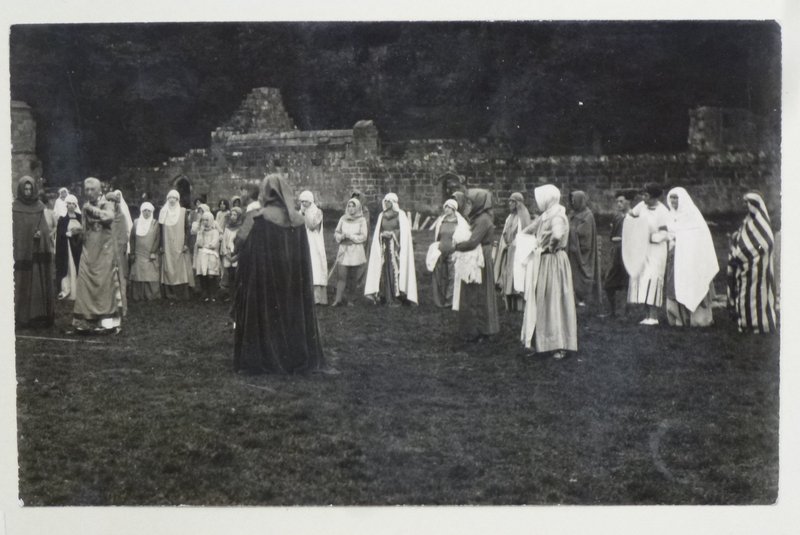
Courtesy of Robinson Library, Newcastle University
Patrons of the pageant – the Bell family
The Bell family were one of the leading late nineteenth and early twentieth century industrialist dynasties influential in both the North Yorkshire countryside and the north east manufacturing region. Having had manufacturing interests in early nineteenth century Newcastle-upon-Tyne, by mid-century, as the Cleveland iron industry boomed, the Bells had turned their attention to establishing works and an industrial village at Port Clarence on the north bank of the River Tees. After decades of success, Bell Brothers merged with Middlesbrough’s Dorman Long at the turn of the twentieth century to form one of Britain’s largest iron and steel manufacturers. Beyond the firm, several generations of the family also played important roles in the cultural, economic, philanthropic and political life of Middlesbrough and the surrounding area, as councillors, aldermen and mayors, as well as serving as patrons of charitable causes and philanthropic initiatives.
Lady Florence Bell - playwright, philanthropist and wife of steel magnate Sir Hugh Bell - was a leading figure in the associational and philanthropic life of the district. As a social investigator she authored At the Works (1907), a celebrated study exploring the lives of the ironworker families in the manufacturing town of Middlesbrough. Bell penned a number of other books, plays and pageants that often reflected her ideologies, social concerns and interest in philanthropic initiatives. A number of her plays were performed in London, and her Yorkshire Pageant supporting the preservation and restoration of windows at York Minster was performed in 1921. But the pageant at Mount Grace was something different. It brought proceedings to and focused upon the home of the Bell’s, reflecting the family’s active interest in the history of the site, which had been in evidence since Sir Isaac Lowthian purchased it in 1898. Building upon the foundations of the ruins and an existing manor house constructed in the seventeenth century, the family commenced an extensive programme of enlargement and refitting during 1900-1901. They employed the architect Ambrose Poynter, who tried to keep the buildings medieval character, and restoring using traditional Arts and Crafts methods. Such was the value placed upon recapturing the monastic history of the site by Sir Isaac Lowthian Bell that not only did he fund continued excavation works following on from those started by Sir William St John Hope in the 1890s, but he also paid for the reconstruction of a monk’s cell (Cell 8) between 1901-1905.
Planning the Pageant
Bringing thousands of performers and spectators from across North Yorkshire and County Durham to Mount Grace Priory involved significant planning and substantial cost. Plans for the pageant were underway two years before the performance, with the pageant’s producer Edith Craig recalling a meeting with Lady Bell in moonlight amid the ruins of the Monastery in 1925 when she said ‘We are going to do a pageant, and we shall have once more the Carthusians living other again in the Cloister of the monastery’.
The Accounts Book for the pageant provides an insight into the meticulous planning and investment that went into organising the pageant, recording expenses for accommodation, carpenters, costumes, printing and research, while also capturing the array of individuals, suppliers and travel companies involved in bringing the pageant and its performers together. Correspondence between Lady Bell and her step-daughter Gertrude Bell, the famed ‘Queen of the Desert’ so influential in the politics of the Kingdom of Iraq, also reflected the vast undertaking the proposed pageant constituted. Of the scale of the pageant, a March 1926 letter from Gertrude Bell to her step-mother declared ‘You take my breath away by writing of 500 people doing the Pageant’, before enquiring a month later ‘Has a pageant got a text? (forgive the ignorance of the question!) If so I trust that you will send it to me to read’. Writing from Baghdad a month before her July 1926 death, Gertrude, who had been instrumental in setting up museum provision in Iraq, declared ‘decidedly a pageant is a much bigger undertaking than a museum’. She further speculated that ‘the pageant must be wonderful’.
As well as providing an insight into personal and cultural exchanges between within the family about the pageant, Gertrude Bell’s letters also reveal the challenges of planning and funding a pageant amidst wider economic turmoil, owing to downturn and strike in the coal, iron, steel and associated industries. In May 1926 she expressed concerns for Lady Bell at the impact that the General Strike might have brought in interrupting plans for the Mount Grace performance. Letters from Gertrude Bell to her father also unveil the mechanisms behind the funding of the pageant (which would go on to make a £807 12s 1d loss from an outlay of £2,557 16s 1d), including the sale of valued items to fund the pageant, with Gertrude writing ‘It is sad about the sale of the Dickens books and letters, but what a large sum they fetched! On the whole it is clear that the pageant is worth more than the satisfaction of knowing that there were reposing in shelves and in drawers. Still I am sure that it cost Mother a pang to part with them’.
The pageant was initially planned to take place a year earlier, in 1926, and was designed by Lady Bell as a golden wedding celebration for herself and Sir Hugh Bell. Family bereavement in the form of the deaths of Gertrude Bell and her brother Hugo Bell in that year, however, saw the pageant postponed. Final preparations instead took place in the summer of 1927. A number of rehearsals attracted the attention of the press, and raised the profile of the pageant, with the Northern Echo covering the preparations in some detail - accompanied by photographs of Mount Grace’s ruins.
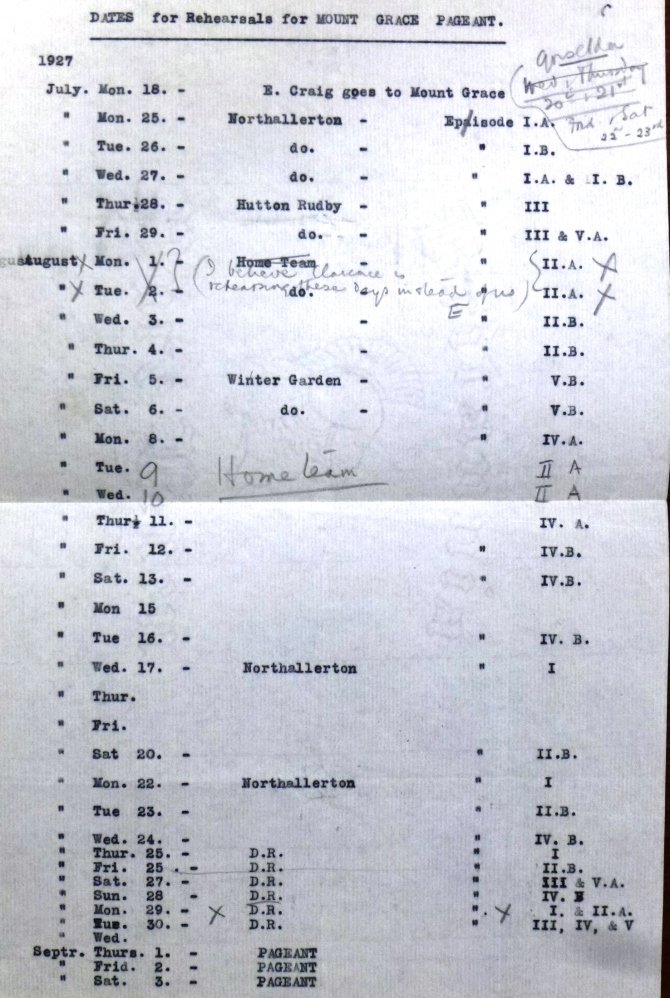
Courtesy of Robinson Library, Newcastle University
The Pageant
Despite encountering numerous hurdles along the way - including bereavement, conflict and strike - after years in preparation, bringing with it significant financial investment, detailed logistical organisation and months in rehearsals, the pageant was held across three days from 1st to 3rd September 1927. The pageant opened with actress Elizabeth Robins as ‘The Spirit of the Past’ declaring
'You who are assembled here to-day within the walls of this ancient cloister will see an attempt to reconstruct something of the what is called the Past, to reproduce in living portraiture the outward actions of some of those whose destinies have been interwoven with Mount Grace.'
The pageant’s chronological focus spanned from 1084 through to the abandonment of Mount Grace at the Dissolution, while the geographical reach covered France and various scenes in England. Scenes in England included a medieval castle in the midlands and followed in 1430 by Mount Grace; Hampton Court in 1535 with King Henry VII at Tennis; a street in London in the same year thronging with hoards present to see Carthusian priors pass to execution; with proceedings then returning to Yorkshire where the prior eventually succumbed in the final episode – the Dissolution of Mount Grace. Armed with their one shilling ‘Book of the Words’, the pageant attendees were afforded a journey across centuries of Carthusian history, played out by a mixture of celebrated performers, ecclesiastical figures, national politicians, prominent industrialists, landed gentry and military leaders. Alongside members of the Bells’ elite networks were a rich ensemble of cultural and philanthropic organisations to which the industrialist family were affiliated, with a particularly strong representation of a cohort of Women’s Institutes drawn from across North Yorkshire and South Durham.
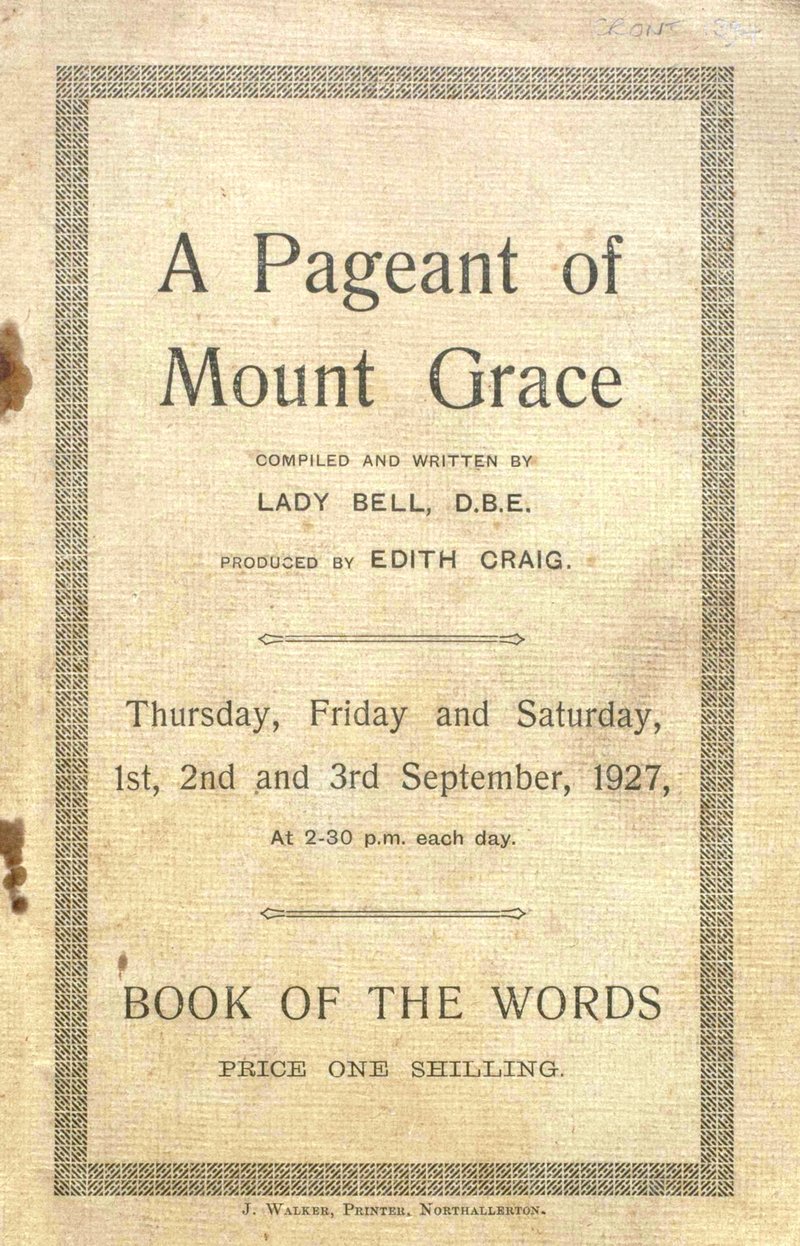
By courtesy of North Yorkshire County Record Office, CRONT 1394
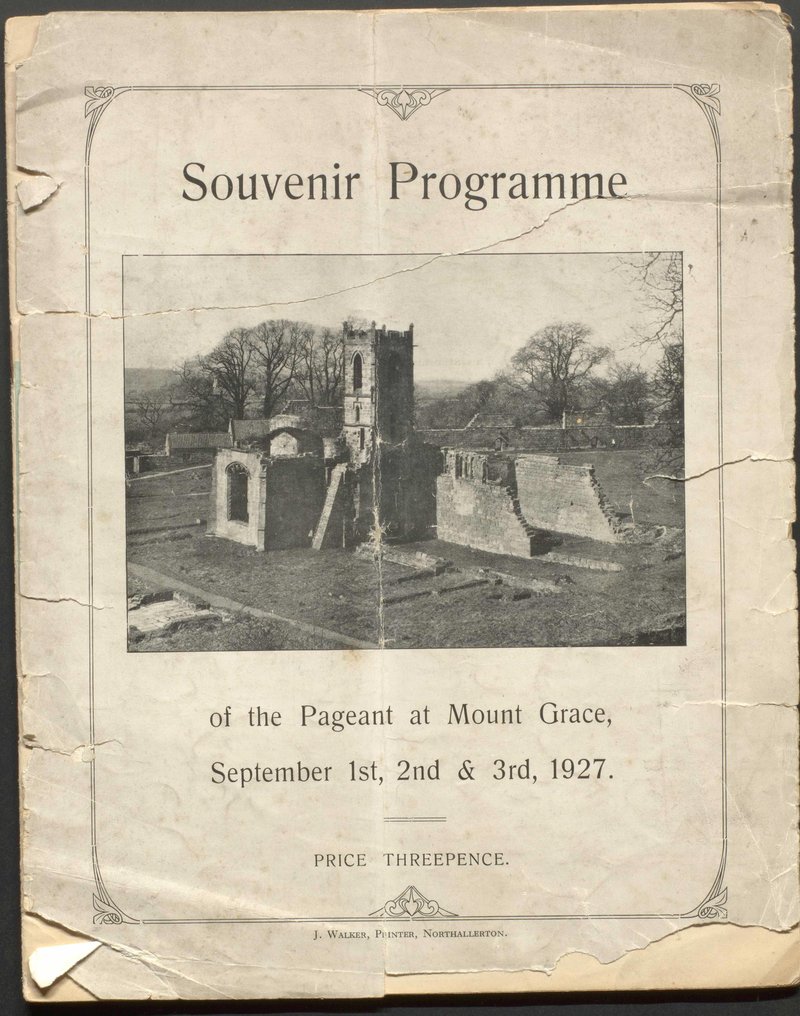
Courtesy of North Yorkshire County Record Office, ZFK
The opening scenes, charting the conversion of Bruno, the founder of the Carthusian Order, and the subsequent foundation of the Order’s first and head monastery at Grande Chartreuse, were played out by members of the Northallerton, Hutton Rudby and Thirsk contingent. King Richard’s court at the Castle in the Midlands was played by the Rounton Grange Group, who hailed from the estate centred around the Bell’s home prior to their move to Mount Grace’s Manor House. The Rounton-led episode boasted Charles Trevelyan, MP for Newcastle Central and son-in-law of Lady Bell as Richard II, alongside his wife Molly Trevelyan as Lady Manners, her sister Lady Richmond playing Lady Beauchamp, with Vice Admiral Sir Herbert Richmond assuming the part of Chaucer. The families’ younger generations were also represented with the Richmond and Bell children having parts to play alongside Mrs Hugh Bell (the widower of ‘Hugo’ Bell), heir to the family dynasty Colonel Maurice Lowthian Bell, and other members of the Pease, Richmond and Trevelyan families. They were joined in the episode by Charles Dorman, director at Dorman Long, who himself was a leading local notable and served alongside Sir Hugh Bell on the Middlesbrough steel manufacturer’s board.
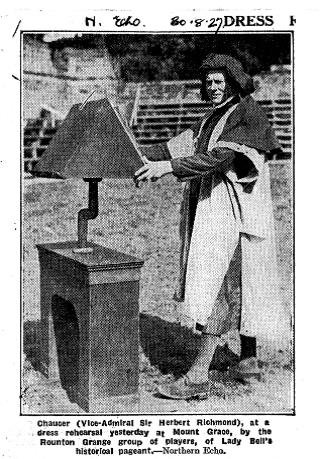
Vice-Admiral Sir Herbert Richmond as Chaucer. Northern Echo. Courtesy of Middlesbrough Reference Library
Moving forward to the late 14th century and the Foundation of Mount Grace, the episode was dominated by performers drawn from WI’s across North Yorkshire. They were accompanied by Morris Dances from the Middlesbrough Winter Garden - Lady Bell’s philanthropic leisure enterprise established in the town as an alternative to the beer houses and pubs of the Edwardian manufacturing town. Following the interval, the pageant sought to capture some of the everyday activities and incidents in the lives of the monks, through the performance of the ceremony associated with the reception of a novice; meals shared on Chapter Feast Days; and a sense of the sacrifice, silence and solitude adopted by the Carthusians. The final two episodes brought to the fray Henry VIII as the villain of the piece - played by Colonel Harington, decorated for military service during the First World War – with the pageant telling the story of the execution of monks in London and several hundred participants in ‘The Pilgrimage of Grace’, stage managed by the Pennymans of Ormesby Hall, one of the leafing families in Cleveland. Fittingly closing the pageant in 1539 was the Dissolution of Mount Grace, recounting the last days of occupancy and the last prior’s taking leave of the world to the Lady Chapel hermit’s cell (which remains today).
The hard work put into the play was recognised at the close of the performance when the players ‘were accorded round after round of cheering’ followed by Sir Hugh Bell stepping into the court to heap praise on the performers and Edith Craig. Craig in turn called for ‘three cheers to the creator of what has been a beautiful pageant’, with Lady Bell fittingly having the last word to bring proceedings to a close.
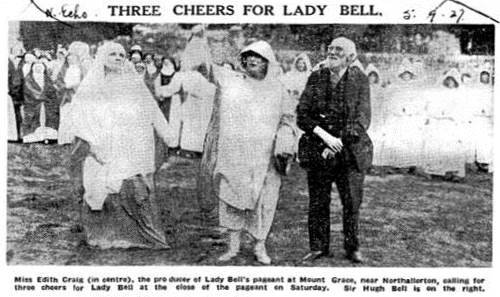
Northern Echo. Courtesy of Middlesbrough Reference Library
Reception, Reviews and Legacy
The pageant was reported extensively across regional newspapers with generally positive reviews, acknowledging the scale of the event and praising Lady Bell in particular. The Northern Echo led on detailed coverage of the pageant from rehearsals through to the launch of the pageant with the headline the ‘Oneness of the Past with the Present’. The North Star reported on the pageant with accompanying photographs of several notables in costume, praising Bell for having brought together people ‘from all parts of Cleveland between Saltburn and here [Mount Grace] — humble farm workers, men of commerce and the Church, women from the dairy and from the drawing room, workers with hands and with brains’. Middlesbrough’s North Eastern Daily Gazette reported how ‘scenes of great enthusiasm marked the close of the final performance’ with all seats occupied and the nearby woodland thronging with hundreds of onlookers. The North Mail & Newcastle Chronicle coverage provided descriptions of the ruins, photographs of the key players and praised Lady Bell and Miss Edith Craig for having ‘performed something in the nature of a miracle’. Further afield The Manchester Guardian confirmed the pageant as ‘an affair of no little art’ singling out the performance of Admiral Sir Herbert Richmond as Chaucer for particular praise.
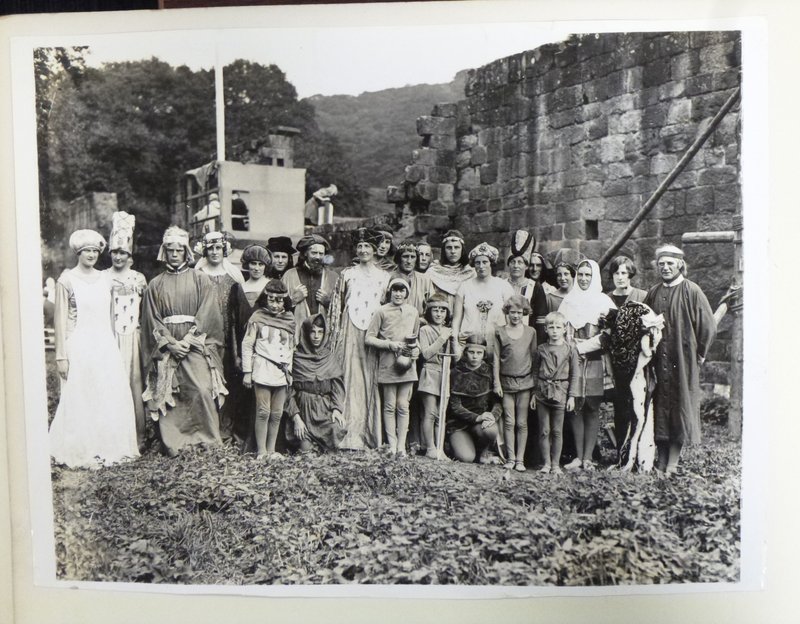
The Players. Courtesy of Robinson Library, Newcastle University
Criticisms of the pageant were minor, and tended to focus on issues with local accents coming through. One newspaper warned attendees against talking to characters ‘off stage’ as to not spoil the illusion - noting an encounter when a Carthusian brother, smoking a pipe, broke his vows of silence to tell one audience member about ‘two good things at Manchester’. Similar criticisms followed from another newspaper in noting how ‘hesitancy in speech and position were occasionally noticeable’ and ‘numerous lines in the book were treated discourteously’, paying particular attention to the ‘accents that spoil the illusion’ noting the how the ‘modernity of enunciation…can hardly be eradicated’.
Despite these minor criticisms of this north country pageant, the event was clearly a positive one, and left behind a legacy remembered for decades to come. Janet E. Courtney’s tribute to Lady Bell on the latter’s death in 1930 noting how ‘she once staged the History of the Bells' beautiful old Carthusian priory, Mount Grace. Almost half a century later, mourners at the funeral of Sir Hugh and Lady Bell’s grandson (also Sir Hugh Bell) in 1970 recalled ‘the beauty of the a scene from the great pageant of Mount Grace’. Today, a short piece of footage of the pageant survives in the Yorkshire Film Archive, originally recorded for screening at cinemas in nearby Northallerton. The footage not only captures part of the performance but also shows preparation for the pageants and key figures that were in attendance, including Lady Bell greeting guests and Sir Hugh Bell walking amongst the cloister ruins.
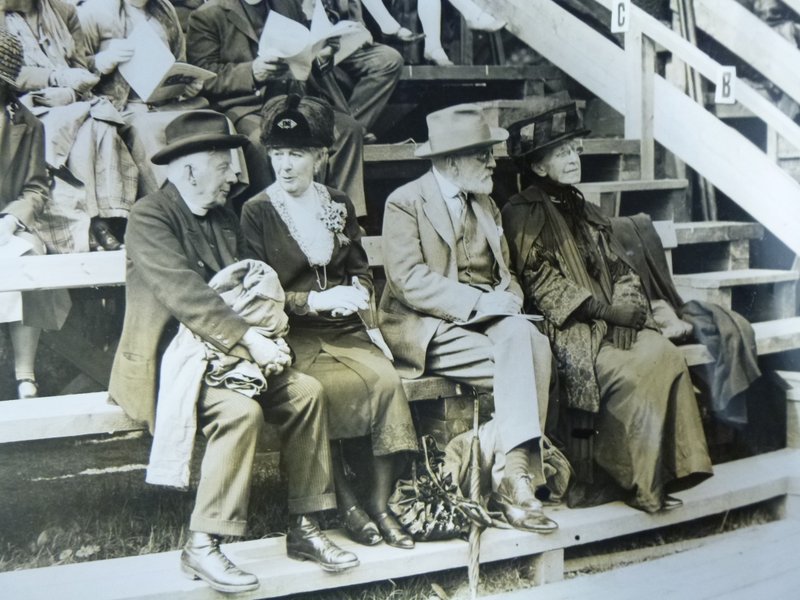
Spectactors at Mount Grace Priory Pageant, including Sir Hugh Bell and Lady Florence Bell right. Courtesy of Robinson Library, Newcastle University
Conclusion
The links harnessed between rural and urban society played an important role in the multifaceted engagement of this leading industrialist family, and particularly the success of The Historic Pageant of Mount Grace Priory. By bringing together representation from Middlesbrough, North Yorkshire rural society and the Bells’ elite networks, albeit with some flaws, this celebration showcased the role of the pageant in wider associational and cultural relations in interwar Britain. The performance and dissemination of the industrial elite’s cultural interest in and knowledge of England’s past through three days of celebration furthermore highlights the role of the Bells as both leading figures in local society and as champions of local and national history.
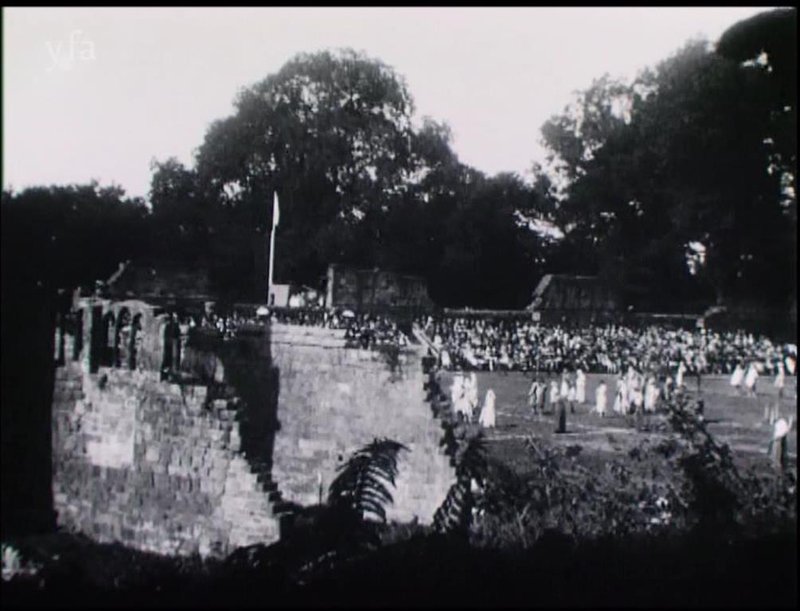
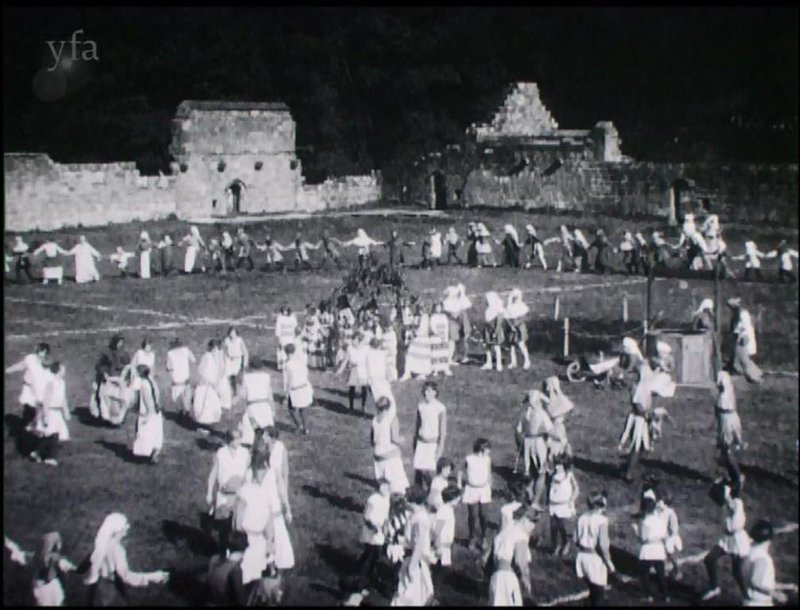
Short Bibliography
North Eastern Daily Gazette
North Star
Northern Echo
North Mail & Newcastle Chronicle
The Manchester Guardian
G. Coppack, Mount Grace Priory, Yorkshire (London, 2014)
Account book, Book of Words, Souvenir Programme and other documents at the North Yorkshire County
Record Office
Letters in the Gertrude Bell Archive
Documents at the Mount Grace Priory, English Heritage
Newspaper cuttings at the Middlesbrough Reference Library
L. Lukitz, A Quest in the Middle East: Gertrude Bell and the Making of Modern Iraq (New York, 2006).
